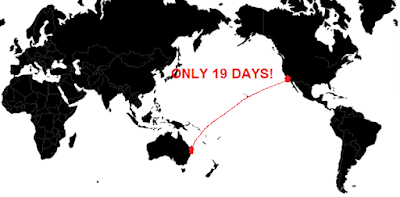In the classic novel, Around the World in 80 Days by Jules Verne, Phileas Fog wagers a £20,000 bet that he can circumnavigate
the globe in 80 days or less. Using a combination
of steamer ships, trains, and alternative modes of transport, such as an
elephant, Fog and his trusted valet battle a herd of bison, a mutiny and
hurricanes until they arrive back in London…. well, I can’t tell you the
end! You will have to read it yourself. But I will say this, if it was up to
me, I would gladly hire Phileas Fog any day to move my belongings from the U.S.
to Australia because… they STILL haven’t arrived.
After 101 days my belongings are “in Singapore
indefinitely.” No joke! The woman from the moving company used those
EXACT words. When I pressed her for more
information she told me she had “no idea” when they would be put on a ship to
Australia. You might be asking yourself,
“Hmmm… I don’t understand. You live in
Australia. So why are your things in Singapore?” Yes! My question exactly. Here’s the best part. I looked it up on a map and the distance from
Brisbane to Singapore is roughly the same distance as from Brisbane to Hawaii. Let me back up and give you the back story.
When I signed my contract with my moving company in
February I was informed my things would go from Texas to… Actually, let’s take
a show of hands. If you were going to
send my belongings from Texas to the east coast of Australia, how would you do
it? Texas to California and then on to
OZ? Brilliant... Well, that’s what they
told me in February. My shipment would
go overland to LA, then it would take 19 days on a ship from LA DIRECTLY to
Brisbane. Woo-hoo! Sounded like a great deal to me. Ahh, the best laid plans.
May 18th: Talk to moving company and find
out my things are bound for Australia. I
am very excited because I figure my things should arrive around the same time
as I will (July 1st).
June 11th: Follow up with moving company
about shipment. Am informed my
belongings left Texas two days prior and are on their way to New York. New York?!?!?! So they are going the LONG WAY around the
world? Two nasty emails from yours truly
to moving company about how they need to look at a map and 7,100 miles (LA to
Brisbane) (and a straight line!) is WAY shorter than the 21,156 miles from New
York to Brisbane.
July 3rd: Send another obnoxious email to
shipping company asking for the name of the ship which is transporting my
belongings. They refuse to give me the
name until the third email. Finally
discover my belongings are on the YM Maturity.
Do a Google search and discover www.vesselfinder.com online.
July 19th: Despite having tracked my ship
online daily for the past three weeks, the novelty has not worn off. However, today I see the Maturity is off the
coast of Somalia. If this rings some
alarm bells for you, you are correct.
That’s where Captain Phillips was captured by pirates. Check my insurance statement from the moving
company regarding what happens in the even my shipping container is lost at
sea.
July 28th: According to vesselfinder.com the Maturity
has stopped in Singapore. Strangely
enough, it is her final destination.
Woa! This is news. What happened to Australia? Promptly contact the shipping company rep who
informs me, “The ship was NEVER supposed to stop in Australia. We knew the whole time it was only going to
Singapore.” Naturally, I asked when my
shipment would leave Singapore, and was told, “We can’t be sure. But it’s two weeks from Singapore here and
then of course, your things will sit in Customs and Quarantine for at least two
weeks.” Kelly: “So, in other words, even
if my things left today they wouldn’t get here before September 1st?” Moving company: “That’s right. But just so you know, they won’t leave today.”
August 25th: Call moving company again for an update. Am informed my belongings are “in Singapore
indefinitely.”
So, to recap, this was Phileas Fog’s round the world
trip, which he managed to make in 80 days.
ALL the way around the world mind you:
This is the one-way trip my belongings are making:
This would have been the trip if my shipment had
gone the western route.
So, what have I learned?
1. I have a strong dislike for shipping
companies. (I’m not allowed per Phelan
family rules to use the word “hate.”
Hence, this was the best way I could think to express myself.)
2. I figure by the time my clothes get here they
will have gone out of fashion and then cycled back around to be trendy
again. Kind of like bellbottoms.
3. I can’t live without a slow cooker.
4. In the event I ever move from Australia I will
sell or give away everything. I plan to
walk on to the plane with my passport, credit cards and only what I can carry.
















